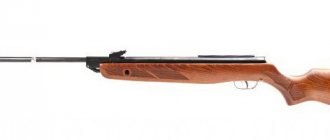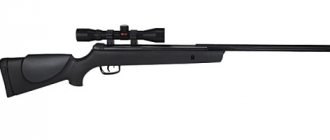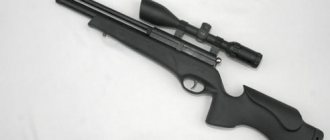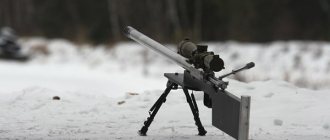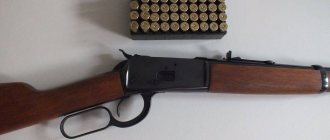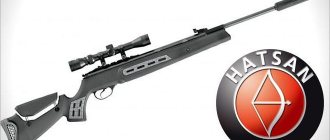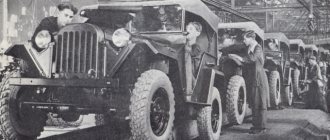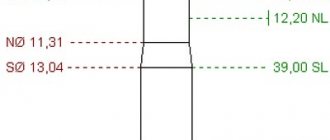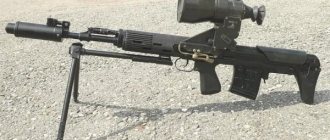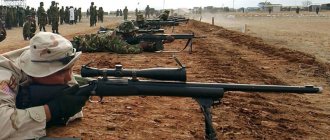The Gamo G-magnum 1250 air rifle is a new product from the Spanish manufacturer Gamo of the same name. A very powerful gun for hunting, which has an increased cylinder size, first used in this type of weapon, 33 mm (usually set to 30 mm). The latest technologies have made this pneumatic the most popular in this Magnum class.
A few words about the manufacturer
Originating in Spain, the world-famous Gamo company has more than 50 years of history as a manufacturer of air guns: bullets, rifles and pistols. In 1961, the company's pilot air pistol was launched on the Spanish market and immediately became popular with consumers due to its excellent quality. The company's first steps were aimed at creating the production of air rifles from guaranteed interchangeable parts.
In 1963, deliveries of the company's products to the UK began. At the same time, Gamo became a participant in international exhibitions. By 1970, the company's products were already supplied to 40 countries. In 1980, business ties began with similar enterprises in the United States, and in 1995 the Gamo USA corporation was founded.
Since 2013, 100% of the company's shares have been owned by the New York-based investment fund Brookman, Rosser, Sherrill & Co. (B,R,S).
The subject of our review, the powerful Gamo Hunter 1250 air rifle, has been supplied to the world market since the beginning of 2000.
About the strengths of the model
Judging by the reviews of the owners, Gamo Hanter 1250 have the following advantages:
- The rifles are easy to operate and maintain.
- High-quality wear-resistant steel is used for the manufacture of trigger mechanisms, and hard wood is used for butts. This explains the high service life of these Spanish “pneumatics”.
- No vibrations during shooting.
- There is no air leakage from the tank, which has a positive effect on shooting accuracy. The compressor is equipped with a very high quality rubber seal.
- The fit of the “iron” in the wooden stock is very high quality.
- Due to the low weight of the piston, the air rifle is very easy to operate.
List of characteristics
This single-shot rifle is loaded by breaking the barrel and combines enormous power and precision. It is designed to fire lead bullets of 4.5/5.5 mm caliber. The bullet speed is 381 m/s (in the open version), and the shot power is 36.3 J (in the open version). The number 1250 in the name refers to the English unit of speed FPS (1250 feet per second).
It is important to note that the rifle is supplied to Russia in a weakened version with a power of 7.5 J and a bullet speed of V0 = 175 m/s. In order to return the full performance of the Gamo Hunter 1250, it is necessary to drill out the bypass hole (remember the ban on owning such a powerful weapon - it is criminally punishable).
The clamping force is 26.5 kg (both versions). Weight is 4.1 kg. The total length is 123 cm, and the barrel length is 400 mm.
Disassembling the Gamo G-Magnum 1250 air rifle
The air gun is sold in a weakened version - with a weak spring, a drilled piston and a narrow bypass. To return the performance, the rifle must be disassembled.
This requires:
- unscrew 2 screws on both sides of the forend and 1 screw at the bottom;
- unscrew the bolt at the back of the trigger;
- remove the stock from the mechanism;
- remove the plastic roller from the piston pusher, which holds it in the guide groove;
- unscrew the coupling behind the release mechanism;
- get the trigger mechanism;
- unscrew the rear compressor plug;
- if the spring is weak, then unscrewing the plug will not require the use of a pressing machine;
- remove the piston and spring guide.
Who is this air rifle suitable for?
Of course, its power is impressive, but not everyone can run through the forest with a four-kilogram rifle. But if you already know what the Diana 54 Airking rifle is, then you will have something to compare with. In any case, this weapon is intended for an experienced and strong user. The fact that the rifle is suitable for a large-sized shooter is also confirmed by the fact that from the middle of the butt plate to the trigger is as much as 37 cm.
The recoil after a shot is such that if you have weak shoulders, it is better not to try to handle the Gamo Hunter 1250. The rubber butt pad on the butt, which is designed to reduce recoil, will not help either. In short, it’s better not to take such a rifle into weak hands - you won’t get any accuracy in the battle, although the weapon itself will have nothing to do with it.
But if you have already completed a couple of years of military service with an SVD, then the Gamo Hunter 1250 is made for you as if by order. Let's take a closer look at the individual options.
Design
Due to its heavy weight, the weapon is not suitable for entertainment or learning shooting skills. This is an excellent sporting rifle and shotgun for hunting purposes (with a heavy duty spring).
The stock is made of black plastic composite and looks a little futuristic, although it is a classic semi-pistol grip. Otherwise, it is an ordinary rifle with a spring-mechanical cocking system. The barrel is made of steel and has 14 grooves. Separately, it is necessary to highlight the barrel closing mechanism. The breech protrudes from the muzzle box, and the compressor fits into its groove. During locking, they are connected and do not allow any play in the barrel. The locking pin is made in the shape of a metal cone and snaps under the steel bolt, which also provides additional support.
Shooting is carried out in single mode, with lead bullets. The initial flight speed will depend on the mass of the cartridge. The manufacturer indicates 390 meters per second, but in fact the gun shoots 250-270. Bullets can be used both classic and with a copper-plated core or with berthollet salt.
During charging, no additional movements are required to open the receiver. The force for a “fracture” is 30 kg.
In addition to the front and rear sights, the Gamo 1250 pneumatics are equipped with a dovetail rail. It is quite long and holds the optics securely.
Double descent. The ATC unit first raises the trigger sear, then removes the hook from it. This reduces the pressing force during shooting and increases accuracy. The safety is of a mechanical type, its lever is located in front of the trigger. The butt of the gun is equipped with a rubber butt pad to reduce recoil. Its position cannot be adjusted.
Operating a rifle will not be difficult for people who know how spring-mechanical models, cocked by breaking the barrel, work. Cocking is accompanied by displacement of the piston, hingedly fixed in the muzzle box. When reaching the barrel, a combat platoon is installed perpendicular to the position of the stock. The safety is manual, so nothing holds the mainspring except the sear. It is turned off by installing a small lever forward. After loading the cartridge, the barrel is placed in its original position and secured with a bolt. The rifle is ready to fire.
Butt
It is made of wood and if it were plastic it would be an absolute disaster for this rifle. The plastic stock of the 1250 would not last long, so it is made in the classic “Monte Carlo” style from impregnated beech (in versions for the American market - from walnut) and equipped with a rubber butt pad.
To prevent the palm from slipping along the handle, there are fish skin linings on both sides. The same pads are also available on the fore-end.
arbalet-airgun
It says that a long time ago, when Russian airgunners armed with files tried to turn “Murka” into at least “Gamo”, there were mighty “Webley Patriots” on Earth. Very few in number, although they were originally from England, they were found mainly overseas.
But the real history of “supermagnums” began with the release to the mass market of a completely new unique development “Gamo Hunter 1250” with a giant 29 x 120 compressor. It was understood that the speed of a 4.5 mm bullet reaches 1250 feet per second, or 380 m/ s (about real indicators - in the article “Speed of a pneumatic bullet”). For comparison, a Makarov pistol sends a bullet (albeit a 9mm one) at a speed of 315 meters per second. In terms of power (33 joules), the new product was one and a half times greater than the most serious samples of the magnum class. Stuffed with original technical solutions, the rifle created a sensation. Moreover, even its name hinted at hunting use, the thought of which was just beginning to occupy the minds of airgunners (see “Air rifles for hunting”).
Powerful pneumatics “Diana”: gentle and gentle “oars”
Other manufacturers began to urgently create something similar to Hunter. “Diana” already had experience in producing high-quality and quite powerful, at the very border, “supermagnums”, series 48-52-54 (see “Diana air rifles”). But, it seems, time was running out, and the Germans, without further ado, simply increased the size of their 34th model, offering it to customers under the name “350 Magnum”.
Quite accurate, soft, well made, it came out completely faceless, without any “zest”. Here in the photo from top to bottom are the “Classic”, “Superior” and “Pro” options. Hmmm... Healthy conservatism is, of course, very German, but it immediately becomes clear why this type of rifle is affectionately called “oars”.
There are versions in a plastic stock, as well as with a shortened barrel. The photo shows the 350 Magnum Professional Compact model.
The price starts at about 30 thousand rubles, and for the “sophisticated” versions it exceeds 40,000.
TTX:
Type of pneumatic - spring-piston Type of cocking - barrel fracture Bullet speed*, m/s - 360 Caliber, mm - 4.5 Weight, g - 3800 Barrel length, mm - 495 Rifle length, mm - 1143 Barrel material - steel Stock material - wood Mounting type - dovetail Fuse - yes
*Note: manufacturer's data is provided here and below. All companies give speed in relation to an ultra-light (less than 0.4 gram) lead-free bullet, which should never be fired, especially from a “supermagnum”. The actual speed of a half-gram bullet for the Diana-350 with the original spring is about 330 m/s, with a 0.68 gram bullet normal for such a weapon - 290 meters per second. A similar extrapolation should be made for any other air rifles. For more information about this, as well as about the selection of ammunition for “supermagnums”, including hunting ones, see the article “Bullets for pneumatics“.
"Hatsan-125" as a symbol of "supermagnum"
However, cool rifles, like luxury cars, are much more conservative than “compact cars” in every sense. Hatsan, over there, regularly experiments even with his “supermagnums”, practically leaving the top model known under the index “135”. First, also briefly about the main model line (for more details, see the article “Hatsan Air Rifles”).
Again from top to bottom: the classic “Hatsan” mod. 125, followed by “125 TH MW” (with “magic wood” camouflage) and “mod 125 Sniper”.
With the first two, everything has long been clear - great power, cheap plastic, soft metal, and the camouflage one also has a flimsy thumb cut-out bridge. Plus some careless assembly and fitting of parts - the barrel can easily look a little into the sky relative to the center line of the compressor or hang sadly. The third model will be more interesting, at least externally. And they vary greatly in price - from about 12 thousand for the classic 125 to almost 20,000 for the Sniper.
TTX:
Design - spring-piston Caliber, mm - 4.5 (.177) Rifle length, mm - 1255 Rifle weight, kg - 3.650 Number of charges, pcs - 1 Initial bullet speed, m/s - 380 Barrel - rifled, steel Barrel length, mm - 500 Bullets used - only lead Sights - approx. strap and front sight Presence of a fuse - yes Stock material - plastic, wood Type of stock - Monte Carlo with cheek rest Possibility of installing optical or collimator sights, front sight - yes Mounting type for optical sight - dovetail
The Sniper, as you can see, is made in the style of the earlier Stryker 1000S.
And everything would be fine, only the sight is too weak for such nonsense (and it would be a monoblock, not high rings), and the price is too high. But it’s still noticeable: the guys tried, they did something clever, the designers cursed in the smoking rooms.
They smoked, apparently, notably... A cadet who thought of placing a sniper rifle on the rest with the BARREL, and not the forearm, would have been immediately killed, fried and eaten by the instructors. And then they managed to stick the bipod to the almost hanging trunk of the “PEROLOMKA”. There is, of course, one option for using them: you can take a photo in a true sniper pose. Then remove it anyway and throw it away immediately.
In terms of design, features of shooting and operation, the Hatsan-125 is not much different from its older brother, the Hatsan Mod 135. Unless, of course, you take into account the smaller volume of the compressor, the weaker spring and the general level of quality.
But the 125th “Hatsan” has one advantage over all other “supermagnums”; it is not by chance that it was initially dubbed the “Gamo Hunter 1250 killer”. The point is the price, which, depending on the store, is twice or even three times lower. Therefore, there is a niche, and a rather large one at that.
“Smersh R4”: “wolfhound” from the Middle Kingdom
However, he also had a rival. This is a Chinese clone of “Diana-350” with a purely Russian name “Smersh R4/R10”. “Ten” is an almost exact copy of the classic “Diana”, adjusted for its origin. This is especially noticeable in the quality of the stock - both the wood itself and the varnish coating. TTX - one to one. The price is about three times lower than the prototype - about 10,000 rubles.
"Smersh R10"
But “Eir Fourth” claims to have some exclusivity. At a price significantly lower (about 8 thousand rubles) than the cheapest “Hatsan”, it surpasses its competitor in the quality of the polymer stock, the almost German softness of the shot and, accordingly, accuracy (see “Powerful pneumatics: the Smersh R4 rifle”). True, like the prototype, it is a little weaker.
"Smersh R4"
Reviews about “Smersh” are generally quite good. Why should it be otherwise, if not only does it have the same plastic as the Stoegers and Crosmans, but also the parts in it are found with the monograms of much more expensive Rugers from a truly German one. It seems that they all come from, if not the same workshop, then factories that are located side by side (“Chinese air rifles”).
Speaking of Stoeger. Its line also includes the “supermagnum” X-50. He, in turn, has a blood brother, but rated at a higher rank, under the long and noble name “Benjamin Trail NP XL 1500”, naturally produced by “Crosman”.
Both of them are based on the Gamo Hunter 1250 platform, but differ from it in many ways. You will find their detailed reviews in “Useful Links”.
Ideal "Hunter" from "Gamo"
How is the progenitor of the “Supermagnum” class doing?
Yes, in general it’s not bad. “Gamo Hunter 1250”, although according to the Internet airgunner’s habit, is positioned below the 350th “Diana”, it does not cost much less - a little over 30 thousand. And for good reason. There are such “Field Target” (FT) competitions. Of all the semi-sports events, for me, they are the pinnacle. Shooting there is carried out at silhouette figures of animals (something like a 3D crossbow-bow), the killing zone of which is highlighted in the target itself (can you imagine how tiny it is for a squirrel?). The device is clear from the photo (can be enlarged). Now imagine: a clear field, the wind is blowing, the grass is in the way, the distances are only approximately known, the shooting angle is most often awkward - an almost complete imitation of approach hunting, except that the prey will not escape anywhere. In a word, everything is very, very difficult, so they mostly shoot from “soft” and, by definition, accurate RSRs.
So, in the spring-piston division, in addition to the quiet 12-16 Joule “Air Arms”, “Weihrauchs” and the already mentioned unique “Diana-54”, two “supermagnums” were successfully lit up - “Gamo Hunter 1250” and “Weihrauch HW” 90". Here they are, in the photo, and the 90th “Weirauch” is short, in the “carbine” design. The appearance clearly does not shine with originality, so what is so special about them? Well, firstly, quality, for one it is supported by a name, for the other - the title of the company's top model. But the main thing: “Weirauch” has a proprietary low-pressure gas spring “Theoben”, while “Gamo” simply installs the same one, only from a domestic manufacturer (you can see the details at this link).
They make it possible, by raising/decreasing the pressure right in the field, to adjust the firing of rifles to perfection. Sighting is still mandatory, whether before competitions or before hunting. Simply put, if necessary, you can increase accuracy at any time by reducing power, and vice versa.
Without creating a special section, I will give here the characteristics of the 90th “Weirauch”, a very iconic model.
TTX:
Caliber 4.5 mm Type: spring-piston (gas spring) Bullet speed 320 ms Loading: single-shot system Ammunition type: lead bullet Barrel: steel, rifled Length 500 mm Weight 4.0 kg Total length 1150 mm Sights: open, possibility of installing an optical sight Trigger: adjustable Safety: automatic Stock material: wood Manufacturer: Weihrauch Sport Germany
Not long ago, a version of the Hunter with a polymer stock, the Gamo Socom 1250, was released.
TTX:
Caliber (mm) - 4.5 Type - Spring-piston pneumatics Bullet speed (m/s) - 380 Type of ammunition - Lead bullets of 4.5 mm caliber. Loading — Single-shot system, cocking by “breaking” the barrel Barrel — Steel, rifled Rifle length (mm) — 1230 Sights — Sighting rib and front sight with fiber-optic threads Safety — Non-automatic Trigger — Adjustable Stock material — Wood (walnut)/impact-resistant polymer. Weight (kg) - 4.45
“Hunter/Socom 1250” is generally a very useful rifle for modifications. Below you will find an absolutely fantastic video about how, with skillful hands, you can successfully not even shoot, but hit the target with it at a 200-meter distance! To hell with pneumatic guns, I’m sure that small shooters will understand my delight.
Turkish monster
And of course, I haven’t forgotten about the hero of ancient legend - the mighty “Webley Patriot”. It is still produced under this name, but most shooters on all continents know it as... "Hatsan MOD 135". Yes, this is it, truly the greatest and most terrible of all “Hatsans”, the famous 135th, the most powerful spring-piston rifle in the world, and so on and so forth.
I remember well my first acquaintance with the 135th. I dream of only one thing: to try in action its version with an under-barrel platoon - “Torpedo 155”, it is even larger and more massive due to additional parts.
It was on the road, they weren’t shooting with pneumatics. Towards evening, already at the base, I brought a Stryker and began to rub in the audience something about magnums. Then a guest from Samara said, “Now I’ll show you a real Hatsan,” went to the car and returned with THIS. We had already been, as they say, “sitting for a long time”; we didn’t want to go anywhere, so we shot at the traditional targets for such situations at about 20 meters. With an open sight, not the first time, but everyone managed to hit the “targets”. The only thing is that after several cockings the little hands began to tremble treacherously.
But in principle, I note, albeit artificially heated, but universal delight. Including the appearance - the walnut stock of the company’s flagship is really awesome, especially compared to the Stryker. Nevertheless, most people still associate “aircraft” with the Tirov IZH-38. What is characteristic is that no one was outraged or amused by the owner-confirmed maximum effective range of sighting fire from the 135 with optics of 35-40 meters (see “Sighting distances of an air rifle for hunting”).. Severe practices, they were sober even that evening correlated the capabilities of weapons with reality.
More details about the features of the spring-piston top model of the Turkish company can be found in the article “Powerful pneumatics: “HATSAN MOD 135”. The Hatsan 135 QE series talks about another new product: the “quiet energy” of a predator - this is the QE series with integrated silencers. This line contains an absolute monster even by the standards of spring-piston “supermagnums”, the 45-joule 7.62-mm “Carnivore” (“Predator”).
Would I like to have a Hatsan-135? Yes. Maybe not the main rifle, but still. Moreover, low-pressure gas springs are now being made for it too. For those for whom it will become the one and only, I would only advise them to shoot more at the correct distances, without being distracted by reading abusive posts on the Internet or by other pneumatics. And take the dumbbells out of the closet. Then, most likely, some sense will come of it.
What about ours?
More recently, the Izhevsk Mechanical Plant released a version of the MP-513M hunting rifle weakened to 7.5 joules. It differs from its progenitor only in the spring. Read more in the article “Powerful pneumatics: MP-515 “Barracuda”.
Passion for the “supermagnum”: to each his own
And yet the question is logical: why the hell are such rifles needed, huge, heavy, from which you can’t really shoot at distant targets? The answer lies on the surface - for plinking and hunting. That is, this is a kind of analogue of the UAZ, which is used either for extreme “rides” (but the price of a prepared car is for people who are not poor), or for everyday use off-road in the rural outback (for people who are not rich).
In the pneumatic world, there is a clear predominance of sports-“sniper” sentiments, therefore “supermagnums”, and even “magnums”, are not in honor. Agree, it would be strange if in the relevant circles the opinion was considered absolute that the only type of fishing is fly fishing, truly the pinnacle of fishing, very complex and, to be honest, not cheap. What now, with a float you can only sit on the shore under cover of darkness?
Let's still look for information. Let us again turn to the experience of North America, Australia and other “armed” countries, where the “aircraft” is used strictly for its intended purpose - either for teaching children, or for entertainment, or for hunting. For sniping, they use the appropriate weapons.
Unfortunately, the majority of those who use cheap but powerful rifles are not very friendly with Twitter and Facebook, and they are not inclined to replicate their own large-caliber physiognomy throughout the planet through “selfies.” You can communicate with them mainly on hunting forums, and narrowly regional ones (such as “Spearingfield Deer Killers”, moderator Homer Simpson).
There, especially in the outback, people also live poorly. He fundamentally does not like credit cards, politicians and New Yorkers (reminds me of nothing?), but, trying to save money, he really loves rifles for cheap Soviet-Russian ammunition. For them, the same “Gamo” even produces the “Viper Express” pneumatic shotgun, which shoots “nine” shot from rechargeable containers. It has been successfully used to kill poisonous snakes, quails, and all kinds of rodent pests. Scree, yes, not very much, but up to ten meters (Gamo itself insists on 35!) the shot fulfills all the tasks. And for pennies, sorry, cents.
In general, the use of pneumatics looks something like this.
Having decided that pizza and beans are already boring, Mike takes his trusty “super magnum” 0.22 caliber (they really prefer the 5.5 mm versions) and goes to his favorite field with sparse copses. About fifteen minutes later, the fat rabbit, not noticing the hidden shooter, approaches 25 yards and immediately collapses, hit by a 20-grain “ultrashock.” And at the same time, gentlemen, we have not half a carcass of a mess of bone fragments and crushed flesh, but a good 5 pounds of purely beaten dietary meat. Well, and paws for souvenirs.
What do you say is not real? Absolutely vital, even for the Hatsan, even for the 4.5 mm caliber. The minimum requirements for rabbit hunting (according to British data, however) are a speed of 750 ft/s, caliber 0.177 (pictured). Any “supermagnum” is capable of taking an animal or bird weighing up to three or four kilos, and not necessarily to the head, as is required from weaker but more accurate rifles. To do this, it is better to use heavy and even slightly modified bullets in the 4.5 mm caliber. The only thing is, do not confuse a rabbit with a hare, which is much more difficult to hunt. Our Mike, had the expected shooting range been longer and the animal had been more nimble, would probably have taken his trusty .223 Rem or shotgun off the wall.
Do you think, for example, that Russian Mikhail would refuse to have a really cool pneumatic gun, the stories about which are full of stories on the Internet. Let's say "Daystate MK4 iS". Or at least the “Beeman R9” shown in the photo with the rabbits, known to us as the “Weihrauch HW 85”. But for Mikhail the price of “Daystate” will be about 120 thousand rubles. And Mike, as a practical person who doesn’t believe in fairy tales, will almost certainly prefer the terribly popular “Gamo Bone Collector” for 200 dollars (or the generally not very targeted Russian “Saiga” 7.62 x 39 for the same 600 bucks) to the “Biman”, which costs 600 dollars ). They are sold in the states by an order of magnitude more than cool PSRs, but the owners shoot more often than post photos on the Internet.
In general, everything, as always, comes down to money.
This is our problem, that, without access to normal weapons or funds for cool pneumatics, many are trying to replace them with “elephant killers”, which have their own rather narrow niche. And at the same time, in the wake of the dominant “sniper” sentiments, demand that he jump above his head.
All these attempts are very reminiscent of the purely Russian experience of radically remaking completely serial “Priors” into some kind of sports car. The Yankees, on the contrary, prefer to take an ancient jalopy for 200 bucks, rip out the hood, the dead engine, stuff a truck engine into the compartment and drive the hot rod around the neighborhood. Because I want something like that. And for daily trips they have a normal car.
After an expensive crossover, you are happy to change into an UAZ and into the fields and forests. Doesn’t a person who regularly and thoughtfully shoots “on paper” with a Weihrauch HW 77 sometimes want to play with the muscular “135”, or even use it for its main purpose? But then it will be nice to go to the forum and read the posts of young hatsan breeders. Here he could wisely instruct them, divide the meters of distance and centimeters of accuracy of enthusiastic beginners by ten, talking about his own experience. Great, right?
PS And yet, understanding the specificity of “elephant killers,” I can’t resist. For the attention of those who dream of a powerful rifle, but are going to spend what is called all their savings on it, I offer the following express review. That’s what we’ll call it – “Postscript for the “supermagnum”.
Trunk
The steel barrel is 45 cm long and has 12 grooves. It ends in a cylindrical muzzle with a diameter of 33 mm, which helps to somewhat muffle the sound of the shot. Although at the maximum speed of the bullet in the full-fledged version, it is guaranteed to overcome the sound barrier, and the clap turns out to be noticeably loud. The muzzle, equipped with a front sight bolt, can be easily removed if desired.
The barrel is screwed in very firmly and pinned into the barrel sleeve. The latter is inserted without play into the “horns” of the rifle’s air cylinder. The quality of the metal prevents the risk of play in the future.
Comparison of Gamo and Hatsan
It cannot be said that the named models of air guns have much in common. Gamo rifles in most cases are characterized by minimal weight and extreme ease of operation.
The latter fact is due to the simplicity of the weapon’s design. Hatsan rifles, in turn, are heavier. At the same time, the power indicators of the weapon will also be slightly higher. Moreover, upgrading such rifles can be somewhat complicated, but tuning pneumatics from the Gamo company will not pose any particular difficulties.
Rear sight and sight
The sighting bar (rear sight) has a combined plastic-metal design and can be adjusted horizontally and vertically. It is also permissible to install an optical sight on a rifle. For this purpose, a dovetail-type attachment point is welded to the barrel coupling.
A telescopic sight must be selected based on the strength of its design, since with strong recoil a considerable load is applied to it. Usually, when installing it, the muzzle is removed.
The main pros and cons of the rifle
| Advantages | Flaws |
| The combat piston is made from solid billet steel | Heavy weight - 3.3 kg |
| The chamber with a compressor groove milled for it firmly secures the barrel, preventing any backlash when firing | In the factory version, the muzzle is an imitation; a muffler must be purchased additionally |
| The manual safety is located in front of the trigger, which does not require additional movements before shooting | Large force for rifle cocking, which is 30 kg |
| Double escapement, mechanism made of metal | Has strong double recoil |
| Long dovetail that securely mounts optics | Manual safety, this makes the gun dangerous for beginners |
How to reduce recoil in Gamo Hunter 1250
A gas spring instead of a coiled one will achieve this. It is a cylinder with a rod filled with inert gas. If a coiled spring, when fired, always generates an oscillatory process, as a result of which a so-called double recoil occurs, throwing the barrel to the side and reducing accuracy, then a gas spring provides a single, shorter and softer recoil.
Today, such springs are manufactured in a factory and are widely offered on the airgun market. Installing it in the Gamo Hunter 1250 really improves the characteristics of the rifle: it reduces recoil and increases shooting accuracy.
What to look for when buying a pneumatic gun?
Before purchasing a Gamo Hunter 1250, the rifle must be thoroughly inspected. Judging by reviews from owners, the following faults are often encountered in this model:
- Misalignment of the “pneumatic” barrel and the cylinder. It is normal if the barrel is tilted down no more than two degrees. After a few shots, he settles into place. It's worse if the misalignment is five degrees. In this case, the owner may have difficulty installing optical sights. In some “pneumatics” the barrel can be noticeably turned to the right or left. Since the dovetail sight is welded parallel to the barrel and not the cylinder, a slight bevel is not a problem. However, judging by the reviews of some owners, this flaw does not suit many aesthetically.
- The presence of a long crack in the stock near the largest screw.
- The presence of too much lubricant in the rifle mechanism: gun oil and technical petroleum jelly. Treatment with a lubricant increases the service life of the rifle’s hardware. For wooden surfaces, a large amount of Vaseline is undesirable. Otherwise, this substance destroys the bond between wood fibers.
- The presence of burrs on the inner surface of the stock. It is formed as a result of its rough processing.
- Poor quality processing of the muzzle. By shining a flashlight into the barrel of the rifle, you can see that the rifling in the barrel is located 1-2 cm before the muzzle. Ideally, they are not visible in the barrel channel.
- The presence of rusty screw heads that secure the rubber butt plate.
What powerful air rifles are most popular on our market?
Among the most common models are Gamo Hunter 1250 and Hatsan 125 (made in Turkey, shown in the photo below).
Both of them are powerful long rifles designed for tall users. In terms of shot power, they are almost identical. Both manufacturers, Spanish and Turkish, declare the ability of their products to hit feathered targets at distances of up to one hundred and fifty meters (with an aimless shot). You can aim from both rifles, as noted above, at targets at a distance of up to 100 m. And here the character of the “Turkish” compared to the “Spanish” begins to appear.
Its impact is such that many owners who use optics experience a characteristic injury in the form of a broken right eyebrow. During recoil, the barrel performs a complex movement back and forth and up (in exactly that sequence!).
What is the reason for such crazy returns? The fact is that the “Turkish” has a very large volume of the compressor cylinder, so that when the air is compressed in it, significant energy accumulates, which, on the one hand, is transferred to the bullet when fired, and on the other, causes the appearance of a recoil impulse directed opposite to the bullet impulse ( the law of conservation of energy, nothing can be done).
The only way to get rid of such recoil is to replace the conventional coil spring with a gas spring. Despite all the apparent difficulties, this really helps to cope with the recoil of both the Hatsan and the Gamo, and also significantly improves the accuracy of fire.
Features of choosing optics
The specifics of choosing optics for a rifle depend on various factors. When deciding this issue, you should take into account the required magnification of the sight, the appearance of the aiming mark, and the cost of the optical kit. It is imperative to take into account the adaptability of the scope to a specific rifle model .
The choice of sight magnification will depend on the intended operating conditions of the weapon and the distance at which the shots will be fired. For long-range shooting, it is best to use sights with high magnification and vice versa.
Among other things, you should pay attention to the reliability of the sighting device, because if there is strong recoil during a shot, its performance characteristics can be significantly reduced.
So what to choose - “Spanish” or “Turkish”?
Another important disadvantage of the Turkish rifle is the use of cheaper materials. So, its butt is plastic and hollow, so the heavy barrel pulls the rifle down when aiming, requiring considerable effort to level it. And although the price decreases significantly when materials become cheaper, if we are talking about weapons, then the inevitable decrease in the quality of the product can play a fatal role. There are known cases when the plastic stock simply burst in the cold.
The barrel itself of the Hatsan 125 is very long - 510 mm versus 400 mm for the Gamo. It’s not very convenient to wade through thickets with it, although in general the “Turkish” is half a kilo lighter than the “Spanish”.
Users voice many complaints about the quality of Turkish springs. The strength of their elasticity decreases by 30 percent after several dozen shots. But the Turkish manufacturer supplies its rifles to the Russian market without any modifications in order to reduce the power of their shot to the permitted 7.5 J, simply inserts a weaker spring, and in the delivery set adds a full-fledged one, with which the shot power is the same as from a full-fledged Gamo.
By what principle should you choose between Hatsan and Gamo hunter 1250? User reviews confirm the identity of their characteristics, but at the same time they all emphasize that the “Turkish” needs more modifications, a kind of rifle tuning.
In general, the choice between them depends on financial capabilities. If you are strong enough and trained, but you are not able to buy “Spanish flu”, since its typical price today is about 31.5 thousand rubles, then do not worry. A Turkish rifle will give you the same pleasure from target shooting and hunting for much less money (from 11.5 to 13.5 thousand rubles), but it will require great muscle effort and patience when fine-tuning it to the desired condition. Have a good hunting!
Features of using this weapon model
In most cases, air rifles presented by Gamo are aimed at recreational shooting and small game hunting. Such models are very well suited for learning. It will be quite easy for a person who has not dealt with weapons to understand all the nuances of operation. This is due to the maximum simplicity of the weapon design. Modernized and improved models are used by professional athletes.
What types of pneumatic bullets are there, what shape, caliber, for what purpose? Review of bullets for a 4.5 mm air rifle, their features, flight speed, lethal power. A detailed review of the Kalashnikov Junker-4 pneumatic assault rifle is here. Its technical characteristics, equipment, video review.
